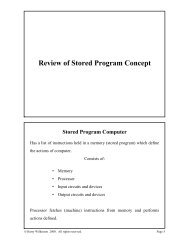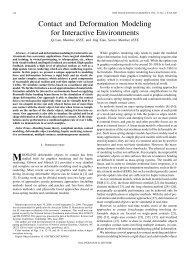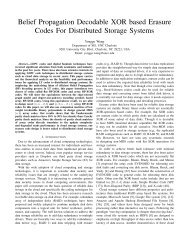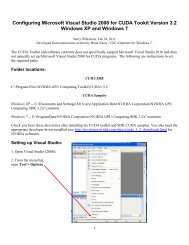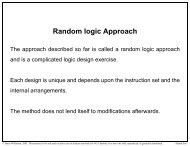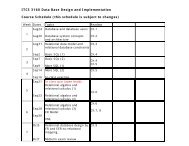Genetic Algorithms
Genetic Algorithms
Genetic Algorithms
Create successful ePaper yourself
Turn your PDF publications into a flip-book with our unique Google optimized e-Paper software.
<strong>Genetic</strong> <strong>Algorithms</strong>
GA Quick Overview<br />
Developed: USA in the 1970’s<br />
Early names: J. Holland and K. DeJong (1975)<br />
Typically applied to:<br />
Discrete & continuous optimization<br />
Attributed features:<br />
not too fast<br />
good heuristic for combinatorial problems<br />
Special Features:<br />
Traditionally emphasizes combining information from good<br />
parents (crossover)<br />
many variants, e.g., reproduction models, operators
<strong>Genetic</strong> algorithms<br />
Holland’s original GA is now known as the simple<br />
genetic algorithm (SGA)<br />
Other GAs use different:<br />
Representations<br />
Mutations<br />
Crossovers<br />
Selection mechanisms
SGA technical summary tableau<br />
Representation<br />
Recombination<br />
Mutation<br />
Parent selection<br />
Survivor selection<br />
Speciality<br />
Binary strings<br />
N-point or uniform<br />
Bitwise bit-flipping with fixed<br />
probability<br />
Fitness-proportionate<br />
All children replace parents<br />
Emphasis on crossover
Representation<br />
Phenotype space<br />
Genotype space =<br />
{0,1}<br />
Encoding<br />
L<br />
(representation) 10010001<br />
10010010<br />
010001001<br />
011101001<br />
Decoding<br />
(inverse representation)
SGA reproduction cycle<br />
1. Select parents for the mating pool<br />
(size of mating pool = population size)<br />
3. Shuffle the mating pool<br />
4. For each consecutive pair apply crossover with<br />
probability p c<br />
, otherwise copy parents<br />
5. For each offspring apply mutation (bit-flip with<br />
probability p m<br />
independently for each bit)<br />
6. Replace the whole population with the resulting<br />
offspring
SGA operators: 1-point crossover<br />
<br />
<br />
<br />
Choose a random point on the two parents<br />
Split parents at this crossover point<br />
Create children by exchanging tails<br />
P c<br />
typically in range (0.6, 0.9)
SGA operators: mutation<br />
Alter each gene independently with a probability p m<br />
p m<br />
is called the mutation rate<br />
Typically between 1/pop_size and 1/ chromosome_length
SGA operators: Selection<br />
A<br />
3/6 = 50%<br />
Main idea: better individuals get higher chance<br />
Chances proportional to fitness<br />
Implementation: roulette wheel technique<br />
Assign to each individual a part of<br />
the roulette wheel<br />
Spin the wheel n times to select n<br />
1/6 = 17%<br />
individuals<br />
B<br />
C<br />
2/6 = 33%<br />
fitness(A) = 3<br />
fitness(B) = 1<br />
fitness(C) = 2
An example after Goldberg ‘89 (1)<br />
Simple problem: max x 2 over {0,1,…,31}<br />
GA approach:<br />
Representation: binary code, e.g. 01101 13<br />
Population size: 4<br />
1-point xover, bitwise mutation<br />
Roulette wheel selection<br />
Random initialization<br />
We show one generational cycle done by hand
x 2 example: selection
X 2 example: crossover
X 2 example: mutation
The simple GA<br />
Has been subject of many (early) studies<br />
still often used as benchmark for novel GAs<br />
Shows many shortcomings, e.g.,<br />
Representation is too restrictive<br />
Mutation & crossovers only applicable for bit-string &<br />
integer representations<br />
Selection mechanism sensitive for converging<br />
populations with close fitness values<br />
Generational population model (step 6 in SGA repr.<br />
cycle) can be improved with explicit survivor selection
Alternative Crossover Operators<br />
Performance with 1 Point Crossover depends on the order that<br />
variables occur in the representation<br />
more likely to keep together genes that are near each<br />
other<br />
can never keep together genes from opposite ends of<br />
string<br />
this is known as Positional Bias<br />
can be exploited if we know about the structure of<br />
our problem, but this is not usually the case
n-point crossover<br />
Choose n random crossover points<br />
Split along those points<br />
Glue parts, alternating between parents<br />
Generalisation of 1 point (still some positional bias)
Uniform crossover<br />
Assign 'heads' to one parent, 'tails' to the other<br />
Flip a coin for each gene of the first child<br />
Make an inverse copy of the gene for the second child<br />
Inheritance is independent of position
Crossover OR mutation?<br />
A long debate: which one is better / necessary / main vs.<br />
background<br />
Answer (at least, rather wide agreement):<br />
it depends on the problem, but<br />
in general, it is good to have both<br />
both have different roles<br />
mutation-only-EA is possible, xover-only-EA generally would not<br />
work
Crossover OR mutation? (cont’d)<br />
Exploration: Discovering promising areas in the search space,<br />
i.e., gaining information on the problem.<br />
Exploitation: Optimising within a promising area, i.e., using<br />
existing information.<br />
Crossover is explorative, it makes a big jump to an area<br />
somewhere “in between” two (parent) areas<br />
Mutation is exploitative, it creates random small diversions,<br />
thereby staying near (in the area of ) the parent
Crossover OR mutation? (cont’d)<br />
Only crossover can combine information from two parents<br />
Only mutation can introduce new information (alleles)<br />
Crossover does not change the allele frequencies of the<br />
population (thought experiment: 50% 0’s on first bit in the<br />
population, ?% after performing n crossovers)<br />
To hit the optimum you often need a ‘lucky’ mutation
Other representations<br />
Gray coding of integers (still binary chromosomes)<br />
Gray coding is a mapping that means that small changes in the<br />
genotype cause small changes in the phenotype (unlike binary<br />
coding). “Smoother” genotype-phenotype mapping makes life<br />
easier for the GA<br />
Nowadays it is generally accepted that it is better to encode<br />
numerical variables directly as<br />
Integers<br />
Floating point variables
Integer representations<br />
Some problems naturally have integer variables, e.g., image<br />
processing parameters<br />
Others take categorical values from a fixed set e.g. {blue,<br />
green, yellow, pink}<br />
N-point / uniform crossover operators is recommended<br />
Extend bit-flipping mutation to make<br />
“creep” i.e., more likely to move to similar value<br />
Random choice (esp. categorical variables)<br />
For ordinal problems, it is hard to know correct range for creep,<br />
so often use two mutation operators in tandem
Real valued problems<br />
Many problems occur as real valued problems, e.g.<br />
continuous parameter optimisation f : n <br />
Illustration: Ackley’s function (often used in EC)
Mapping real values on bit strings<br />
z [x,y] represented by {a 1<br />
,…,a L<br />
} {0,1} L<br />
• [x,y] {0,1} L must be invertible (one phenotype per genotype)<br />
: {0,1} L [x,y] defines the representation<br />
L 1<br />
y x<br />
j<br />
(<br />
a1,...,<br />
aL)<br />
x (<br />
aL<br />
j<br />
2 ) [<br />
x,<br />
y]<br />
L<br />
<br />
2 1<br />
<br />
j0<br />
Only 2 L values out of infinite are represented<br />
L determines possible maximum precision of solution<br />
High precision long chromosomes (slow evolution)
Floating point mutations 1<br />
General scheme of floating point mutations<br />
x <br />
i<br />
i<br />
x<br />
, ..., xl x x1,<br />
..., x l<br />
1<br />
LB UB <br />
x , x<br />
,<br />
i<br />
i<br />
Uniform mutation:<br />
x drawn randomly (uniform) from LB , UB<br />
i<br />
Analogous to bit-flipping (binary) or random resetting<br />
(integers)<br />
<br />
<br />
<br />
<br />
i<br />
i
Floating point mutations 2<br />
Non-uniform mutations:<br />
Many methods proposed,such as time-varying range<br />
of change etc.<br />
Most schemes are probabilistic but usually only make<br />
a small change to value<br />
Most common method is to add random deviate to<br />
each variable separately, taken from N(0, ) Gaussian<br />
distribution and then curtail to range<br />
Standard deviation controls amount of change (2/3<br />
of deviations will lie in range (- to + )
Crossover operators for real valued GAs<br />
Discrete:<br />
each allele value in offspring z comes from one of its<br />
parents (x,y) with equal probability: z i<br />
= x i<br />
or y i<br />
Could use n-point or uniform<br />
Intermediate<br />
exploits idea of creating children “between” parents<br />
(e.g., arithmetic recombination)<br />
z i<br />
= x i<br />
+ (1 - ) y i<br />
where : 0 1.<br />
The parameter can be:<br />
• constant: uniform arithmetical crossover<br />
• variable (e.g. depend on the age of the population)<br />
• picked at random every time
Single arithmetic crossover<br />
• Parents: x 1<br />
,…,x n<br />
and y 1<br />
,…,y n<br />
<br />
• Pick a single gene (k) at random,<br />
• child 1<br />
is:<br />
x<br />
1,...,<br />
xk<br />
, yk<br />
(1 )<br />
<br />
x<br />
k<br />
,...,<br />
x<br />
n<br />
• reverse for other child. e.g. with = 0.5
Simple arithmetic crossover<br />
• Parents: x 1<br />
,…,x n<br />
and y 1<br />
,…,y n<br />
<br />
• Pick random gene (k) after this point mix values<br />
• child 1<br />
is:<br />
x ,..., x , y x <br />
k<br />
(1 )<br />
, ..., y (1 <br />
1 k 1<br />
k 1<br />
n<br />
)<br />
• reverse for other child. e.g. with = 0.5<br />
<br />
x<br />
n
Whole arithmetic crossover<br />
• Most commonly used<br />
• Parents: x 1<br />
,…,x n<br />
and y 1<br />
,…,y n<br />
<br />
• child 1<br />
is:<br />
a x (1 a)<br />
<br />
• reverse for other child. e.g. with = 0.5<br />
y
Permutation Representations<br />
<br />
<br />
<br />
Ordering/sequencing problems form a special type<br />
Task is (or can be solved by) arranging some objects in a<br />
certain order<br />
<br />
Example: sort algorithm: important thing is which elements occur<br />
before others (order)<br />
Example: Travelling Salesman Problem (TSP): important thing is<br />
which elements occur next to each other (adjacency)<br />
These problems are generally expressed as a permutation:<br />
<br />
if there are n variables then the representation is as a list of n<br />
integers, each of which occurs exactly once
Permutation representation: TSP example<br />
<br />
<br />
<br />
Problem:<br />
• Given n cities<br />
• Find a complete tour with<br />
minimal length<br />
Encoding:<br />
• Label the cities 1, 2, … , n<br />
• One complete tour is one<br />
permutation (e.g. for n =4<br />
[1,2,3,4], [3,4,2,1] are OK)<br />
Search space is BIG:<br />
for 30 cities there are 30! 10 32<br />
possible tours
Mutation operators for<br />
permutations<br />
Normal mutation operators lead to inadmissible<br />
solutions<br />
e.g. bit-wise mutation : let gene i have value j<br />
changing to some other value k would mean that k<br />
occurred twice and j no longer occurred<br />
Therefore must change at least two values<br />
Mutation parameter now reflects the probability that<br />
some operator is applied once to the whole string,<br />
rather than individually in each position
Insert Mutation for permutations<br />
Pick two allele values at random<br />
Move the second to follow the first, shifting the rest<br />
along to accommodate<br />
Note that this preserves most of the order and the<br />
adjacency information
Swap mutation for permutations<br />
Pick two alleles at random and swap their positions<br />
Preserves most of adjacency information (4 links<br />
broken), disrupts order more
Inversion mutation for permutations<br />
Pick two alleles at random and then invert the substring<br />
between them.<br />
Preserves most adjacency information (only breaks two<br />
links) but disruptive of order information
Scramble mutation for<br />
permutations<br />
Pick a subset of genes at random<br />
Randomly rearrange the alleles in those positions<br />
(note: subset does not have to be contiguous)
Crossover operators for permutations<br />
“Normal” crossover operators will often lead to<br />
inadmissible solutions<br />
1 2 3 4 5<br />
5 4 3 2 1<br />
1 2 3 2 1<br />
5 4 3 4 5<br />
Many specialized operators have been devised which<br />
focus on combining order or adjacency information<br />
from the two parents
Order crossover<br />
Idea is to preserve relative order that elements occur<br />
Informal procedure:<br />
1. Choose an arbitrary part from the first parent<br />
2. Copy this part to the first child<br />
3. Copy the numbers that are not in the first part, to<br />
the first child:<br />
starting right from cut point of the copied part,<br />
using the order of the second parent<br />
and wrapping around at the end<br />
4. Analogous for the second child, with parent roles<br />
reversed
Order crossover example<br />
Copy randomly selected set from first parent<br />
Copy rest from second parent in order 1,9,3,8,2
Partially Mapped Crossover (PMX)<br />
Informal procedure for parents P1 and P2:<br />
2. Choose random segment and copy it from P1<br />
3. Starting from the first crossover point look for elements in that segment of<br />
P2 that have not been copied<br />
4. For each of these i look in the offspring to see what element j has been<br />
copied in its place from P1<br />
5. Place i into the position occupied j in P2, since we know that we will not<br />
be putting j there (as is already in offspring)<br />
6. If the place occupied by j in P2 has already been filled in the offspring k,<br />
put i in the position occupied by k in P2<br />
7. Having dealt with the elements from the crossover segment, the rest of the<br />
offspring can be filled from P2.<br />
Second child is created analogously
PMX example<br />
Step 1<br />
Step 2<br />
Step 3
Cycle crossover<br />
Basic idea:<br />
Each allele comes from one parent together with its position.<br />
Informal procedure:<br />
1. Make a cycle of alleles from P1 in the following way.<br />
(a) Start with the first allele of P1.<br />
(b) Look at the allele at the same position in P2.<br />
(c) Go to the position with the same allele in P1.<br />
(d) Add this allele to the cycle.<br />
(e) Repeat step b through d until you arrive at the first allele of P1.<br />
2. Put the alleles of the cycle in the first child on the positions they<br />
have in the first parent.<br />
3. Take next cycle from second parent
Cycle crossover example<br />
Step 1: identify cycles<br />
Step 2: copy alternate cycles into offspring
Edge Recombination<br />
Works by constructing a table listing which edges are<br />
present in the two parents, if an edge is common to<br />
both, mark with a +<br />
e.g. [1 2 3 4 5 6 7 8 9] and [9 3 7 8 2 6 5 1 4]
Edge Recombination 2<br />
Informal procedure once edge table is constructed<br />
1. Pick an initial element at random and put it in the offspring<br />
2. Set the variable current element = entry<br />
3. Remove all references to current element from the table<br />
4. Examine list for current element:<br />
If there is a common edge, pick that to be next element<br />
Otherwise pick the entry in the list which itself has the shortest list<br />
Ties are split at random<br />
5. In the case of reaching an empty list:<br />
Examine the other end of the offspring is for extension<br />
Otherwise a new element is chosen at random
Edge Recombination example
Multiparent recombination<br />
Recall that we are not constricted by the practicalities of<br />
nature<br />
Noting that mutation uses 1 parent, and “traditional” crossover<br />
2, the extension to a>2 is natural to examine<br />
Been around since 1960s, still rare but studies indicate some<br />
usefulness<br />
Three main types:<br />
Based on allele frequencies, e.g., p-sexual voting generalising<br />
uniform crossover<br />
Based on segmentation and recombination of the parents, e.g.,<br />
diagonal crossover generalising n-point crossover<br />
Based on numerical operations on real-valued alleles, e.g., center<br />
of mass crossover, generalising arithmetic recombination<br />
operators
Population Models<br />
SGA uses so-called generational model:<br />
each individual survives for exactly one generation<br />
the entire set of parents is replaced by the offspring<br />
At the other end of the scale are steady-state models:<br />
one offspring is generated per generation,<br />
one member of population replaced,<br />
Generation Gap<br />
the proportion of the population replaced<br />
1.0 for GGA, 1/pop_size for SSGA
Fitness Based Competition<br />
Selection can occur in two places:<br />
Selection from current generation to take part in<br />
mating (parent selection)<br />
Selection from parents + offspring to go into next<br />
generation (survivor selection)<br />
Selection operators work on whole individuals<br />
i.e., they are representation-independent
Implementation example: SGA<br />
Expected number of copies of an individual i<br />
E( n i<br />
) = • f(i)/ f<br />
( = pop.size, f(i) = fitness of i, f avg. fitness in pop.)<br />
Roulette wheel algorithm:<br />
Given a probability distribution, spin a 1-armed<br />
wheel n times to make n selections<br />
No guarantees on actual value of n i<br />
Baker’s SUS algorithm:<br />
n evenly spaced arms on wheel and spin once<br />
Guarantees floor(E( n i<br />
) ) n i<br />
ceil(E( n i<br />
) )
Fitness-Proportionate Selection (FPS)<br />
Problems include<br />
One highly fit member can rapidly take over if rest<br />
of population is much less fit: Premature<br />
Convergence<br />
At end of runs when fitnesses are similar, lose<br />
selection pressure<br />
Highly susceptible to function transposition<br />
Scaling can fix last two problems<br />
Windowing: f’(i) = f(i) - t<br />
where is worst fitness in this (last n) generations<br />
Sigma Scaling: f’(i) = max( f(i) – ( f - c • f<br />
), 0.0)<br />
where c is a constant, usually 2.0
Function transposition for FPS
Rank – Based Selection<br />
Attempt to remove problems of FPS by basing selection<br />
probabilities on relative rather than absolute fitness<br />
Rank population according to fitness and then base<br />
selection probabilities on rank where fittest has rank <br />
and worst rank 1<br />
This imposes a sorting overhead on the algorithm, but<br />
this is usually negligible compared to the fitness<br />
evaluation time
Tournament Selection<br />
All methods above rely on global population statistics<br />
Could be a bottleneck esp. on parallel machines<br />
Relies on presence of external fitness function which<br />
might not exist: e.g. evolving game players<br />
Informal Procedure:<br />
Pick k members at random then select the best of<br />
these<br />
Repeat to select more individuals
Tournament Selection 2<br />
Probability of selecting i will depend on:<br />
Rank of i<br />
Size of sample k<br />
higher k increases selection pressure<br />
Whether contestants are picked with replacement<br />
Picking without replacement increases selection<br />
pressure<br />
Whether fittest contestant always wins<br />
(deterministic) or this happens with probability p
Two Special Cases<br />
Elitism<br />
Widely used in both population models (GGA,<br />
SSGA)<br />
Always keep at least one copy of the fittest solution<br />
so far<br />
GENITOR: “delete-worst”<br />
From Whitley’s original Steady-State algorithm (he<br />
also used linear ranking for parent selection)<br />
Rapid takeover : use with large populations or “no<br />
duplicates” policy
Example application of order based GAs: JSSP<br />
Precedence constrained job shop scheduling problem<br />
<br />
<br />
<br />
<br />
<br />
<br />
J is a set of jobs<br />
O is a set of operations<br />
M is a set of machines<br />
Able O M defines which machines can perform which<br />
operations<br />
Pre O O defines which operation should precede which<br />
Dur : O M IR defines the duration of o O on m M<br />
The goal is now to find a schedule that is:<br />
Complete: all jobs are scheduled<br />
Correct: all conditions defined by Able and Pre are satisfied<br />
Optimal: the total duration of the schedule is minimal
Precedence constrained job shop scheduling GA<br />
<br />
<br />
Representation: individuals are permutations of operations<br />
Permutations are decoded to schedules by a decoding procedure<br />
take the first (next) operation from the individual<br />
look up its machine (here we assume there is only one)<br />
assign the earliest possible starting time on this machine, subject to<br />
<br />
<br />
<br />
<br />
<br />
<br />
<br />
machine occupation<br />
precedence relations holding for this operation in the schedule created so<br />
far<br />
fitness of a permutation is the duration of the corresponding schedule (to<br />
be minimized)<br />
use any suitable mutation and crossover<br />
use roulette wheel parent selection on inverse fitness<br />
Generational GA model for survivor selection<br />
use random initialisation
JSSP example: operator<br />
comparison




